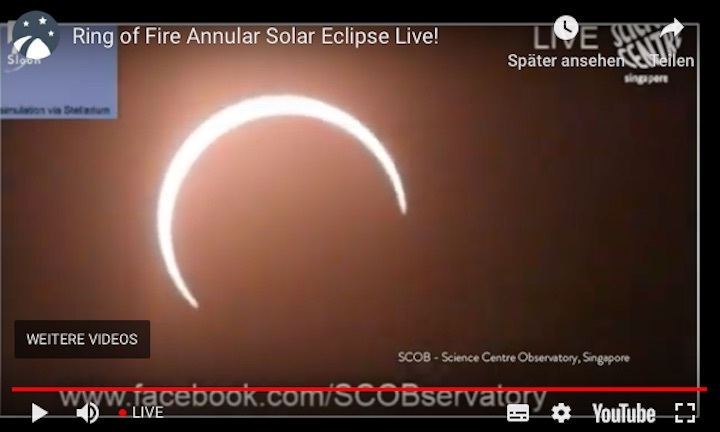26.12.2019

The last solar eclipse of 2019, a so-called "ring of fire" eclipse, occurs Thursday (Dec. 26) and should thrill skywatchers lucky enough to see it in the Eastern Hemisphere. But if you don't live in a place where it's visible, don't worry. You can watch it live online today, Dec. 25, like a cosmic Christmas gift.
The Dec. 26 solar eclipse will be an annular solar eclipse, in which the moon does not completely cover the sun as it transits across the star's face. From the Earth, where the eclipse is visible, this leaves a brilliant ring of light around the moon in what observers call a "ring of fire." IMPORTANT: Be sure to wear proper eye protection like eclipse glasses if you observe the eclipse in person!
You'll be able to watch the solar eclipse on Space.com, courtesy of Slooh, beginning at 10 p.m. EST tonight, Dec. 25 (0300 GMT). You'll be able to watch it directly from Slooh.com here.
According to Timeanddate.com, today's annular solar eclipse will begin at 9:23 p.m. EST (0223 Dec. 26 GMT) as a partial solar eclipse, then make its first peak as the "ring of fire" at 10:34 p.m. EST (0334 GMT) in Saudi Arabia. The 88-mile (142 km) visibility path of "ring of fire" will then move across Bahrain, Qatar, the United Arab Emirates, Oman, India, Sri Lanka, Sumatra, Singapore, Borneo, the Philippines, and the U.S. territory of Guam, making it visible to potentially millions of skywatchers.
Webcasts like the one from Slooh can expand that audience around the world for hopeful skywatchers unable to make it to the Eastern Hemisphere. You won't even need safety glasses to view these events online. The eclipse ends Dec. 26 at 3:05 a.m. EST (0805 GMT).
Today's Christmas solar eclipse is a double celebration of sorts for Slooh, which celebrates its 16th year providing membership access to robotic telescopes around the world. Slooh's webcast will begin here on Dec. 25 at 10 p.m. EST (0300 GMT) and last just over two hours. The company is offering a free one-week trial membership to observers as well.
"Hosted by Chief Astronomical Officer Paul Cox, our team of experts will discuss what makes this type of solar eclipse special and how amateur astronomers and students use Slooh's robotic telescopes to explore space," Slooh representatives said. "Viewers will be able to ask questions during the show and snap their own photos of the eclipse using Slooh's Starshare camera."
The webcast will feature views from the Middle East, India and Singapore, and will end at 12:01 a.m. EST (0501 GMT).
The Dubai Astronomy Group in the United Arab Emirates is streaming live views of the annular solar eclipse from the Liwa region of Abu Dhabi.
"UAE will be witnessing a rare solar eclipse on 26th December 2019. The event in its entirety is largely a partial solar eclipse, with the 'ring' event lasting just a few minutes only in the Liwa region of Abu Dhabi," organizers said. "It will be visible at sunrise on the Arabian Peninsula (UAE, Saudi Arabia, Oman, and Qatar). Join The Dubai Astronomy Group live to enjoy the unique experience with us. the eclipse will be starting from 7:00 AM And ending at 9:00 AM."
TimeandDate.com has a live video feed of events that often includes views of lunar and solar eclipses around the world.
"At timeanddate.com we chase solar and lunar eclipses with our mobile observatory to give you a LIVE broadcast from celestial events worldwide," the site says.
While timeanddate.com has not stated specific times or a dedicated webcast for the eclipse, the site may include views from the event in the stream above.
Eclipse timing
While the ring effect of the annular solar eclipse will last the longest just east of the Indonesian island of Pulau Gin Besar (it will last 3 minutes and 39.5 seconds), observers in the path of annularity will be able to see some of the event, weather permitting.
Meanwhile, observers across most of Asia, northeastern Africa and northern and western portions of Australia will be able to catch a partial eclipse, according to Space.com's skywatching columnist Joe Rao.
Quelle: SC
+++
„RING OF FIRE“
Ringförmige Sonnenfinsternis begeistert in Asien
Es ist ein Himmelsspektakel, wie es nicht oft - und meist in einem nur kleinen Gebiet - zu sehen ist. Diesmal aber begeisterte eine ringförmige Sonnenfinsternis Menschen in weiten Teilen Asiens - unter anderem auf den Philippinen, in Südindien, Thailand, Singapur, Indonesien und Myanmar.
In weiten Teilen Asiens haben Schaulustige am Donnerstag eine besondere Sonnenfinsternis bestaunen können: Dabei schob sich der Mond genau zwischen Erde und Sonne, verdeckte die Sonne aber nicht komplett und ließ einen leuchtenden Ring frei.
Begonnen hatte das Schauspiel auf der Arabischen Halbinsel, dann zog es sich in einem breiten Streifen über Südindien und Südostasien bis zum Nordpazifik.
In Singapur versammelt sich Hunderte Schaulustige am Hafen, um die Sonnenfinsternis zu bestaunen, der Bundesstaat Odisha erklärte den Donnerstag sogar eigens zum Feiertag - alle Behörden, Gerichte, Schulen und Universitäten blieben geschlossen.
„War aufregend!“
Auch in Bangkok in Thailand freuten sich die Menschen über das Ereignis: „Es war aufregend und gut zu erkennen heute. Obwohl die Sonne nicht ganz bedeckt war, war die Finsternis klar zu erkennen“, freut sich ein Mann.
Quelle: Krone.at
